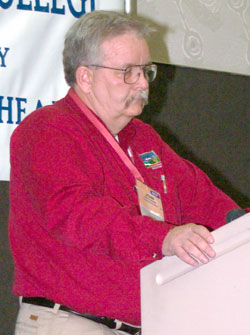9:15 am - 10:45 am • Yuma 29-30 Rooms
PR 104: Managing Your Feed Costs
Dr. John Paterson, Montana State Univ.; Dr. Larry Corah, Certified Angus Beef LLC
Managing Your Feed Costs
 |
John Patterson, animal scientist, shared with attendees of the Cattlemen's College sponsored by Pfizer Animal Health, scenarios and suggestions for supplementation and forage utilization.
|
An important aspect of managing feed costs associated with a cow-calf operation is strategic supplementation of forage-based diets. During a Wednesday Cattlemen’s College® session, Montana State University animal scientist John Paterson offered tips for winter supplementation programs that improve forage utilization while meeting cow nutrient requirements.
Paterson cited a common scenario where the producer has access to plenty of forage, such as range or hay, but the quality of feed resources is low. Consumption of forage is inadequate because of low crude protein (CP) content, and animal performance is lower than desired to meet production objectives. In this situation, Paterson said, feeding a small amount of high-protein supplement (greater than 30%) can improve forage intake and digestion.
In situations where more rapid weight gains are desired, Paterson recommends higher levels of supplementation, even though some sacrifice of forage utilization may result. Relatively high levels of supplementation also may be required when feed resources are in short supply.
“Maybe the quality is good and meets cow requirements, but you need to save forage — stretch it out,” said Paterson. “In that case, you can supplement at higher levels to reduce forage intake. Use supplement as a substitute for part of the forage.”
To know what nutrients may be lacking and require supplementation, producers were urged to have forages analyzed. Supplemental protein is most often needed. Paterson said the choice of supplement depends on the levels of nutrients needed to maintain a balance of energy, or total digestible nutrients (TDN), and CP. He recommended keeping the diet’s TDN-to-CP ratio (%TDN divided by %CP) within a range of 4 to 6. Paterson also urged producers to pay close attention of meeting nutrient requirements for minerals and vitamins.
Larry Corah, Certified Angus Beef LLC (CAB), reminded producers that providing adequate nutrition to the cow impacts the future health, performance and carcass merit of her calf.
“You have to consider what you are doing now (with regard to cow nutrition) and how that will affect you later — especially if you’re looking at a quality target,” said Corah. “Consider the cow’s specific needs during each stage of production and supplement strategically.”
— by Troy Smith
Click here for Corah's proceeding paper
Click here for pdf file

